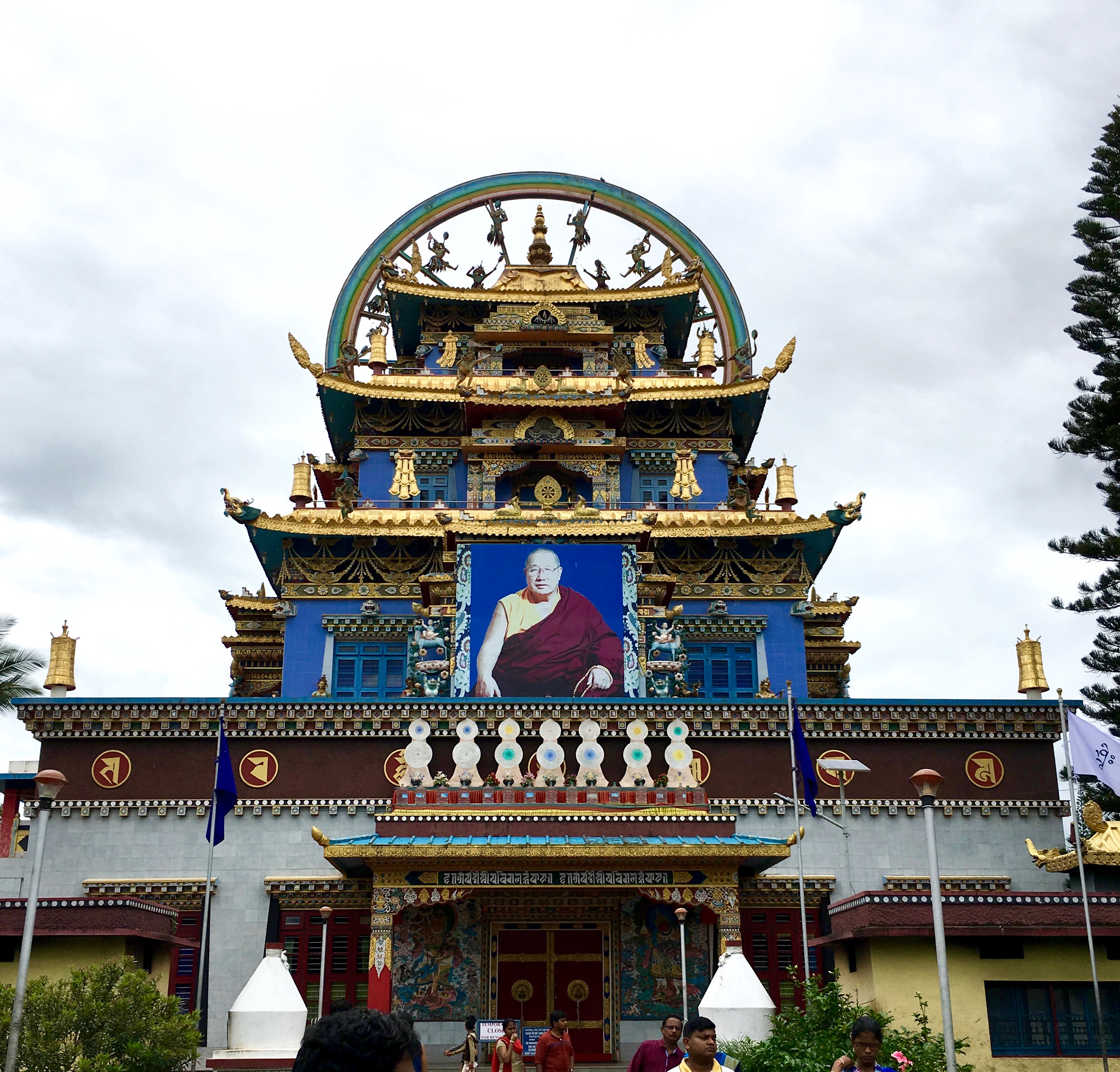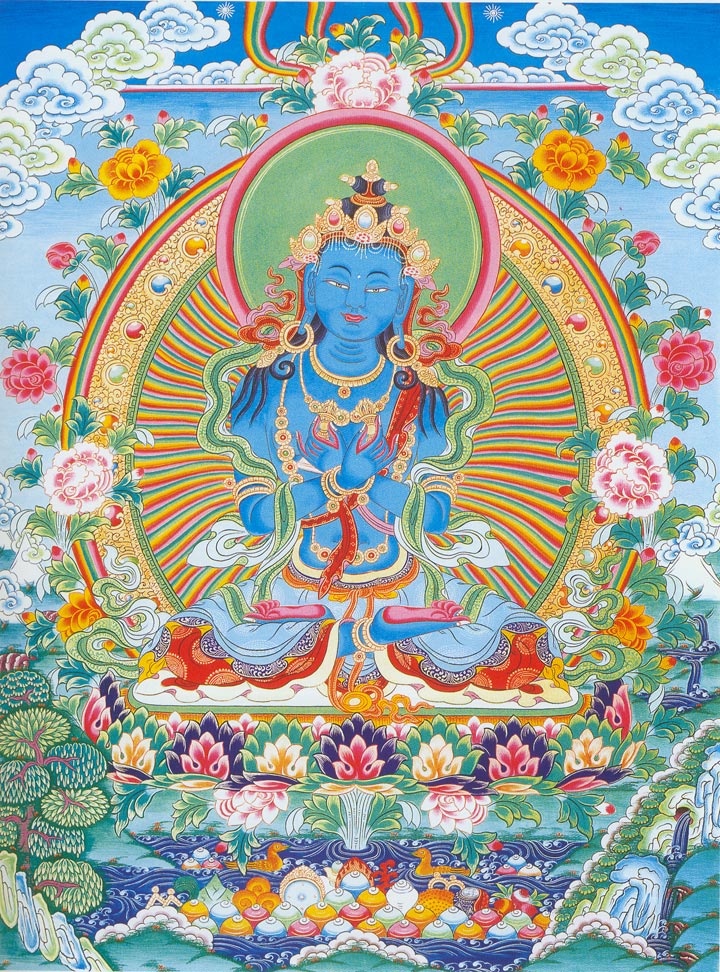|
Palyul
Palyul Monastery (), also known as Palyul Namgyal Jangchub Choling Monastery and sometimes romanized as Pelyul Monastery, is one of the "Six Mother Monasteries" of the Nyingma tradition of Tibetan Buddhism. It was founded in 1665 by Rigzin Kunzang Sherab in Dege, on the eastern edge of Tibet in Kham, a town in today's Baiyü County, Garzê Tibetan Autonomous Prefecture in China's Sichuan province. The monastery is the seat of the Nam Chö Terma of Terton Migyur Dorje. Drubwang Padma Norbu (Penor Rinpoche) was the 11th throneholder of the Palyul lineage. Upon his mahaparinirvana in March, 2009, Karma Kuchen Rinpoche became the 12th throneholder. Namdroling Monastery in Bylakuppe, India, is where the current throneholder to the Palyul lineage has resided since exile from Tibet during Chinese annexation. Dzogchen Lineage of Palyul * Chöku Kuntuzangpo ( Dharmakaya Samantabhadra) * Drugpa Dorjé Changchen (Vajradhara) * Dorje Sempa (Vajrasattva) * Thugjé Chenpo Chenrezig ( ... [...More Info...] [...Related Items...] OR: [Wikipedia] [Google] [Baidu] |
Namdroling Monastery
The Namdroling Nyingmapa Monastery (or Thegchog Namdrol Shedrub Dargye Ling)(བོད་ཡིག ཐེག་མཆོག་རྣམ་གྲོལ་བཤད་སྒྲུབ་དར་རྒྱས་གླིང་།) ( Wylie: ''theg mchog rnam grol bshad sgrub dar rgyas gling'') is the largest teaching center of the Nyingma lineage of Tibetan Buddhism in the world. Located in Bylakuppe, part of the Mysuru district of the state of Karnataka, the monastery is home to a sangha community of over five thousand lamas (both monks and nuns), a junior high school named Yeshe Wodsal Sherab Raldri Ling, a religious college (or shedra for both monks and nuns) and hospital. History The monastery was established by the 11th throneholder of the Palyul lineage, Drubwang Padma Norbu Rinpoche in 1963, following his 1959 exit from Tibet as the second seat of the Palyul Monastery, one of the six great Nyingmapa Mother monasteries of Tibet prior to annexation. The monastery's full ... [...More Info...] [...Related Items...] OR: [Wikipedia] [Google] [Baidu] |
Penor Rinpoche
Kyabjé Drubwang Padma Norbu Rinpoche (), 1932 – 27 March 2009, was the 11th throneholder of the Palyul Lineage of the Nyingma school of Tibetan Buddhism, and said to be an incarnation of Vimalamitra. He was widely renowned in the Tibetan Buddhist world as a master of Dzogchen. He was one of a very few teachers left from his generation who received all his training (in the traditional sense) in Tibet under the guidance of what Tibetan Buddhists consider to be fully enlightened teachers. Biography Life in Tibet The Third Drubwang Padma Norbu Rinpoche, Thubten Legshed Chokyi Drayang (), also known as Do-ngag Shedrub Tenzin Chog-lei Namgyal () was born in 1932, the year of the Water Monkey, in the twelfth month, in the Powo region of Kham, East Tibet. He was recognized in 1936 by the Fifth Dzogchen Rinpoche (Thubten Chokyi Dorje) anKhenpo Ngawang Palzang(also known as Khenchen Ngagi Wangchuk, Ngawang Palzangpo, or Khenpo Ngagchung). Padma Norbu was formally enthroned by his roo ... [...More Info...] [...Related Items...] OR: [Wikipedia] [Google] [Baidu] |
Palyul Lineage
Palyul Monastery (), also known as Palyul Namgyal Jangchub Choling Monastery and sometimes romanized as Pelyul Monastery, is one of the "Six Mother Monasteries" of the Nyingma tradition of Tibetan Buddhism. It was founded in 1665 by Rigzin Kunzang Sherab in Dege, on the eastern edge of Tibet in Kham, a town in today's Baiyü County, Garzê Tibetan Autonomous Prefecture in China's Sichuan province. The monastery is the seat of the Nam Chö Terma of Terton Migyur Dorje. Drubwang Padma Norbu (Penor Rinpoche) was the 11th throneholder of the Palyul lineage. Upon his mahaparinirvana in March, 2009, Karma Kuchen Rinpoche became the 12th throneholder. Namdroling Monastery in Bylakuppe, India, is where the current throneholder to the Palyul lineage has resided since exile from Tibet during Chinese annexation. Dzogchen Lineage of Palyul * Chöku Kuntuzangpo ( Dharmakaya Samantabhadra) * Drugpa Dorjé Changchen (Vajradhara) * Dorje Sempa (Vajrasattva) * Thugjé Chenpo Chenrez ... [...More Info...] [...Related Items...] OR: [Wikipedia] [Google] [Baidu] |
Nyingma
Nyingma (literally 'old school') is the oldest of the four major schools of Tibetan Buddhism. It is also often referred to as ''Ngangyur'' (, ), "order of the ancient translations". The Nyingma school is founded on the first lineages and translations of Buddhist scriptures from Sanskrit into Tibetan in the eighth century, during the reign of King Trisong Detsen (r. 710–755). Nyingma traditional histories consider their teachings to trace back to the first Buddha Samantabhadra (Güntu Sangpo) and Indian mahasiddhas such as Garab Dorjé, Śrī Siṃha and Jñānasūtra. Traditional sources trace the origin of the Nyingma order in Tibet to figures associated with the initial introduction of Buddhism in the 8th century, such as Padmasambhava, Yeshe Tsogyal, Vimalamitra, Vairotsana, Buddhaguhya and Śāntarakṣita, Shantaraksita. The Nyingma tradition is also seen having been founded at Samye, Samyé, the first monastery in Tibet. Nyingma teachings are also known for having be ... [...More Info...] [...Related Items...] OR: [Wikipedia] [Google] [Baidu] |
Baiyü County
Baiyü County ( or Pelyül) () is a county in far western Sichuan, China on the border with the Tibet Autonomous Region. It is under the administration of the Garzê Tibetan Autonomous Prefecture. Administrative divisions * Jianshe Town (建设镇) * Jinsha Township (金沙乡) * Ronggai Township (绒盖乡) * Zhangdu Township (章都乡) * Marong Township (麻绒乡) * Hepo Township (河坡乡) * Rejia Township (热加乡) * Denglong Township (登龙乡) * Zengke Township (赠科乡) * Acha Township (阿察乡) * Maqiong Township (麻邛乡) * Liaoxi Township (辽西乡) * Nata Township (纳塔乡) * Anzi Township (安孜乡) * Gaiyu Township (盖玉乡) * Shama Township (沙马乡) * Shanyan Township (山岩乡) Climate Monasteries The Palyul Monastery is located in Baiyü County as is the Yarchen Monastery and Katok Monastery Katok Monastery (, THL ''Katok Dorjé Den''), also transliterated as Kathok or Kathog Monastery, was founded in 1159 and is ... [...More Info...] [...Related Items...] OR: [Wikipedia] [Google] [Baidu] |
Derge
Derge (; ) is a town in Dêgê County in Garzê Tibetan Autonomous Prefecture in Sichuan, China. It was once the center of the Kingdom of Derge in Kham. History Historically, Derge, which means "land of mercy", was an important centre of Tibetan culture, along with places such as Lhasa and Xiahe. Derge was formerly the seat of the kings of the kingdom of Derge, whose 1300-year lineage was broken with the death of the last male heir in the 1990s. The kingdom was an important industrial, religious and political center in Eastern Tibet. In the early 20th century, the kingdom fell into political struggle between the final heirs to the throne, Djembel Rinch'en and Doje Senkel. The latter, who had enjoyed the backing of the Chinese, yielded the kingdom to China in 1908 in exchange for the ousting of his rival. The palace of the Derge kings was torn down after 1950 and a school was later built on the site.McCue, 241. Culture The town of Derge is famous for its three-storey printing ... [...More Info...] [...Related Items...] OR: [Wikipedia] [Google] [Baidu] |
Tibetan Buddhism
Tibetan Buddhism (also referred to as Indo-Tibetan Buddhism, Lamaism, Lamaistic Buddhism, Himalayan Buddhism, and Northern Buddhism) is the form of Buddhism practiced in Tibet and Bhutan, where it is the dominant religion. It is also in majority regions surrounding the Himalayan areas of India (such as Ladakh, Sikkim, Arunachal Pradesh, and a minority in Himachal Pradesh and Uttarakhand), in much of Central Asia, in the southern Siberian regions such as Tuva, and in Mongolia. Tibetan Buddhism evolved as a form of Mahāyāna Buddhism stemming from the latest stages of Indian Buddhism (which also included many Vajrayāna elements). It thus preserves many Indian Buddhist tantric practices of the post-Gupta early medieval period (500 to 1200 CE), along with numerous native Tibetan developments. In the pre-modern era, Tibetan Buddhism spread outside of Tibet primarily due to the influence of the Mongol Yuan dynasty (1271–1368), founded by Kublai Khan, which had ruled China, ... [...More Info...] [...Related Items...] OR: [Wikipedia] [Google] [Baidu] |
Terma (religion)
Terma (; "hidden treasure") are various forms of hidden teachings that are key to Vajrayana and Tibetan Buddhist and Bon spiritual traditions. In the Vajrayana Nyingma school tradition, two lineages occur: an oral ''kama'' lineage and a revealed ''terma'' lineage. Tradition holds that ''terma'' teachings were originally esoterically hidden by eighth-century Vajrayana masters Padmasambhava and Yeshe Tsogyal, to be discovered at auspicious times by treasure revealers known as tertöns. As such, terma represent a tradition of continuous revelation in Vajrayana and Tibetan Buddhism. Tradition Tradition holds that terma may be a physical object such as a text or ritual implement that is buried in the ground, hidden in a rock or crystal, secreted in a herb, or a tree, hidden in water, or hidden in the sky or in space. Though a literal understanding of ''terma'' is "hidden treasure", and sometimes refers to objects that are hidden away, the teachings associated should be understood as bei ... [...More Info...] [...Related Items...] OR: [Wikipedia] [Google] [Baidu] |
Adi-Buddha
In Vajrayana Buddhism, the Ādi-Buddha () is the "First Buddha" or the "Primordial Buddha". Another common term for this figure is Dharmakāya Buddha. The term emerges in tantric Buddhist literature, most prominently in the Kalachakra.Buswell, Robert E.; Lopez, Jr., Donald S. (2013). ''The Princeton dictionary of Buddhism''. Princeton: Princeton University Press. . Entry on "ādibuddha". "Ādi" means "first", such that the Ādibuddha was the first to attain Buddhahood. "Ādi" can also mean "primordial", not referring to a person but to an innate wisdom that is present in all sentient beings. In Indo-Tibetan Buddhism In Indo-Tibetan Buddhism, the term Ādibuddha is often used to describe the Buddha Samantabhadra (in Nyingma), Vajradhara or Kalachakra (in the Sarma schools).Wayman, Alex; The Buddhist Tantras: Light on Indo-Tibetan esotericism, page 53. There was also a tradition in India which saw Mañjuśrī as the Ādibuddha, as exemplified by Vilāsavajra's commentary to t ... [...More Info...] [...Related Items...] OR: [Wikipedia] [Google] [Baidu] |
Incorporation Of Tibet Into The People's Republic Of China
Tibet came under the control of People's Republic of China (PRC) after the Government of Tibet signed the Seventeen Point Agreement which the 14th Dalai Lama ratified on 24 October 1951, but later repudiated on the grounds that he rendered his approval for the agreement while under duress. This occurred after attempts by the Tibetan Government to gain international recognition, efforts to modernize its military, negotiations between the Government of Tibet and the PRC, and a military conflict in the Chamdo area of western Kham in October 1950. The series of events came to be called the "Peaceful Liberation of Tibet" by the Chinese government, and the "Chinese invasion of Tibet" by the Central Tibetan Administration and the Tibetan diaspora. The Government of Tibet and the Tibetan social structure remained in place in the Tibetan polity under the authority of China until the 1959 Tibetan uprising, when the Dalai Lama fled into exile and after which the Government of Tibet and T ... [...More Info...] [...Related Items...] OR: [Wikipedia] [Google] [Baidu] |




.jpeg/1200px-Tibetan_Buddhism_(214837929).jpeg)

